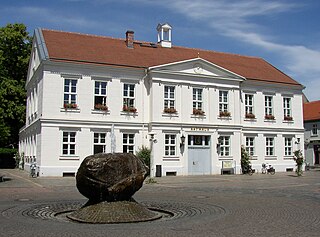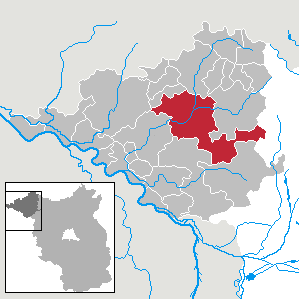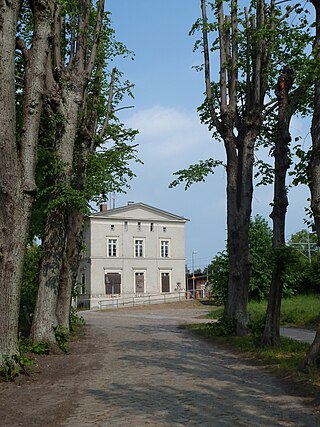Prignitz is a Kreis (district) in northwestern Brandenburg, Germany. Neighboring districts, clockwise from the north, are Ludwigslust-Parchim, Ostprignitz-Ruppin (Brandenburg), Stendal (Saxony-Anhalt), and Lüchow-Dannenberg.

The Altmark is a historic region in Germany, comprising the northern third of Saxony-Anhalt. As the initial territory of the March of Brandenburg, it is sometimes referred to as the "Cradle of Prussia", as by Otto von Bismarck, a native of Schönhausen near Stendal.

Wittenberge is a town of eighteen thousand people on the middle Elbe in the district of Prignitz, Brandenburg, Germany.

Perleberg is the capital of the district of Prignitz, located in the northwest of the German state of Brandenburg. The town received city rights in 1239 and today has about 12,000 inhabitants. Located in a mostly agricultural area, the town has a long history of troops being stationed there and as an administrative center for local government.

Bad Wilsnack is a small town in the Prignitz district, in Brandenburg, Germany. The former pilgrimage site of the Holy Blood of Wilsnack has been officially recognised as a spa town (Bad) since 1929. It is the administrative seat of the Amt Bad Wilsnack/Weisen.

Lenzen (Elbe) is a small town in the district of Prignitz, in Brandenburg, Germany. The town lies to the north of the Löcknitz River, not far from where the Löcknitz flows into the Elbe. It is part of the Amt Lenzen-Elbtalaue.

The Province of Brandenburg was a province of Prussia from 1815 to 1945. Brandenburg was established in 1815 from the Kingdom of Prussia's core territory, comprised the bulk of the historic Margraviate of Brandenburg and the Lower Lusatia region, and became part of the German Empire in 1871. From 1918, Brandenburg was a province of the Free State of Prussia until Prussia was dissolved in 1945 after World War II, and replaced with reduced territory as the State of Brandenburg in East Germany, which was later dissolved in 1952. Following the reunification of Germany in 1990, Brandenburg was re-established as a federal state of Germany, becoming one of the new states.

Pritzwalk is a town in the district of Prignitz, in Brandenburg, Germany. It is situated 20 km west of Wittstock, and 33 km northeast of Wittenberge. The river Dömnitz flows through Pritzwalk.

Putlitz is a town in the district of Prignitz, in Brandenburg, Germany. It is situated 15 km northwest of Pritzwalk, and 35 km northeast of Wittenberge.

Cumlosen is a municipality in the Prignitz district, in Brandenburg, Germany.

Groß Pankow (Prignitz) is a municipality in Prignitz district, Brandenburg, Germany. The municipality was formed in 2001 from the union of municipalities of the former Amt of Groß Pankow/Prignitz and some in Amt Pritzwalk-Land. Amt Groß Pankow/Prignitz was then dissolved.

Rühstädt is a municipality in the Prignitz district, in Brandenburg, Germany. It is located close the confluence of the rivers Havel and Elbe. Rühstädt is famous for its high number of resident white storks and has been awarded the title European Stork Village by the initiative EuroNatur in 1996.

Amt Bad Wilsnack/Weisen is an Amt in the district of Prignitz, in Brandenburg, Germany. Its seat is in Bad Wilsnack.

The Stepenitz is a river in the district of Prignitz, Brandenburg, Germany. It is a right tributary of the Elbe and runs for approximately 84 kilometers. The Dömnitz is a left tributary of the Stepenitz.

Grabow (Meckl) station is located on the Berlin–Hamburg railway in Grabow in the south west of the German state of Mecklenburg-Vorpommern. Together with four other stations, which also opened on 15 October 1846, it is the oldest station in the state. The Neoclassical entrance building, which dates from the opening of the line, and some other buildings in the station area are heritage-listed.

Karstädt station is the station of Karstädt in the German state of Brandenburg. It lies on the Berlin–Hamburg Railway and was opened for freight in 1853 and for passengers in 1859. The Karstädt station of the former Westprignitz District Ring Railway was nearby and was served by passenger services from 1911 to 1975 and by freight traffic until the beginning of the 1990s. The state station's Neoclassical entrance building along with a second building, its goods shed and the paving of the forecourt have heritage protection.

Glöwen station is the station of the town of Glöwen, which is in the municipality of Plattenburg and the German state of Brandenburg. It lies on the Berlin–Hamburg Railway and was opened in 1846. The Glöwen–Havelberg railway branched at the station from 1890 to 1971. The former Light Railway of the District of West and East Prignitz from Viesecke, a small town now in the municipality of Plattenburg, ended in Glöwen from 1900 to 1967. The Neoclassical entrance, which was built at the same time as the line, has heritage protection.

Klein Warnow station is a former station on the Berlin–Hamburg railway in the town of Klein Warnow in the German state of Brandenburg. The station was most important during its first 20 years of operation after its opening in 1846/47, when it was the Prussian border station at the border with Mecklenburg. Since the abandonment of passenger services in 1993, the station has only served corporate purposes. The station building and a number of other buildings have heritage protection.

Perleberg station is a railway station in the municipality of Perleberg, located in the Prignitz district in Brandenburg, Germany.

Weisen station is a railway station in the municipality of Weisen, located in the Prignitz district in Brandenburg, Germany.























